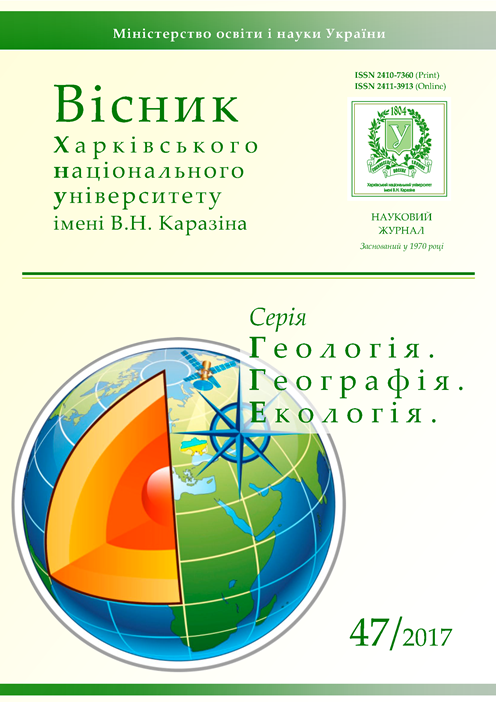Cartographic support for territorial development strategies: actuality, present state and perspectives
Abstract
Formulation of the problem. The authors of the territorial development strategies actively use different means of data visualization (tables, graphs, diagrams, infographics), neglecting maps. For example, only 14 % of the national sustainable development strategies of European countries are provided with maps. The root of the problem is the lack of a basic concept as to creation of strategy maps.
The purpose of the article is to substantiate the relevance of cartographic support for the territorial development strategies, analyze its current state and define prospects.
Main results. Maps are not only vivid and comprehensive means of data visualization, but also material for spatial analysis of the quality in achieving objectives set in the strategies. We consider active use of maps in development strategies relevant for all countries with a high level of geographic literacy and rich cartographic traditions.
The analysis of modern development strategies of various territorial levels (145 documents have been analyzed) allowed us to highlight the following trends in their cartographic support: prevalence of survey maps over thematic ones; dominance of inventory and evaluation analytical maps; schematic character and aesthetic appeal of maps.
At different stages of strategic planning it is appropriate to use various types of maps: at preplanning stage - survey, physical-geographic, socio-economic, ecological maps; when defining goals and objectives - it is expedient to develop at least one map illustrating its contents for each of the objectives set; when choosing the optimal scenario for the territory development - it is recommended to develop forecast maps; at the stage of strategy implementation - it is necessary to reflect the dynamics of indicators set for the objectives.
Conclusions. Creating maps for territorial strategies is a new direction in thematic mapping. Its perspective development requires active involvement of cartographers into the formation of strategies, use of modern cartographic works, in particular web-atlases, and creation of mapping methodology.Downloads
References
2. Батуев, А. Р. Атласная информационная система устойчивого развития регионов Сибири [Текст] / А. Р. Батуев // Интерэкспо Гео-Сибирь. – 2006. – Т. 1, №2. – С. 179-188.
3. Батуев, А. Р. О создании атласа Азиатской России [Текст] / А. Р. Батуев, В. П. Петрищев // Вестник Оренбургского государственного университета. – 2013. – №10 (159). – С. 285-288.
4. Берлянт, А. М. Образ пространства: Карта и информация [Текст] / А. М. Берлянт. – М. : Мысль, 1986. – 240 с.
5. Наукові засади розробки стратегії сталого розвитку України [Текст]: монографія / ІПРЕЕД НАН України, ІГ НАН України, ІППЕ НАН України. – Одеса : ІПРЕЕД НАН України, 2012. – 43-87 с.
6. Топчієв, О. Г. Географія перед новітніми викликами і запитами (український аспект) [Текст] / О. Г. Топчієв, В. І. Нудельман, Л. Г. Руденко // Український географічний журнал. – 2012. – №2. – С. 3-10.
7. Пересадько, В. А. Использование картографического метода в исследовании стратегий устойчивого раз-вития стран Европы [Текст] / В. А. Пересадько, Н. В. Попович // Scientific Letters of Academic Society of Michal Baludansky. – 2016. – Т. 4, №1. – С. 136-139.
8. Планування місцевого сталого розвитку. Посібник з формулювання стратегії сталого місцевого розвитку [Електронний ресурс]. – Режим доступу : http://msdp.undp.org.ua/data/publications/losd_manual_ukr.pdf. –03.11.2017.
9. Попович, Н. В. Картографічне забезпечення стратегій розвитку областей України на період до 2020 року [Текст] / Н. В. Попович // Географічні дослідження: історія, сьогодення, перспективи: матеріали щорічної Міжнародної наукової конференції студентів та аспірантів, присвяченої пам’яті професора Г. П. Дубинського (14-15 квітня 2016 р.). – Х. : ХНУ : Видавництво «Лідер». – 2016. – Вип. 9. – С. 136-138.
10. Руденко, Л. Г. Картографическое обоснование территориального планирования [Текст] / Л. Г. Руденко. – К. : Наукова думка, 1984. – 168 с.
11. Рудько, Г. І. Стратегічна екологічна оцінка та прогноз стану довкілля Західного регіону України: у 2 т. [Текст] / Г. І. Рудько, О. М. Адаменко, Л. В. Міщенко; за ред. Г. І. Рудька, О. М. Адаменка. – Київ-Чернівці : Букрек, 2017. – Т. 2. – 584 с.
12. Світовий центр даних з геоінформатики та сталого розвитку [Електронний ресурс]. – Режим доступу : http://wdc.org.ua/uk. – 02.11.2017.
13. Стратегія розвитку Харківської області до 2020 р [Електронний ресурс]. – Режим доступу : http:// old.kharkivoda.gov.ua/documents/16203/1088.pdf. – 15.11.2017.
14. Тикунов, В. С. Устойчивое развитие территорий: картографо-информационное обеспечение [Текст] / В. С. Тикунов, Д. А. Цапук. – Москва-Смоленск : Изд-во СГУ, 1999. – 176 c.
15. Яковлева, С. И. Картографическое обеспечение зарубежных региональных стратегий [Текст] / С. И. Яковлева // Псковский регионологический журнал. – 2016. – №1 (25). – С. 122-133.
16. Яковлева, С. И. Региональные карты стратегического планирования [Текст] / С. И. Яковлева // Псковский регионологический журнал. – 2015. – №23. – С. 98-106.
17. Atlas of Global Development: A Visual Guide to the World’s Greatest Challenges [Електронний ресурс]. –Режим доступу : https://openknowledge.worldbank.org/handle/10986/6613. – 15.11.2017.
18. Atlas of Sustainable Development Goals 2017 [Електронний ресурс]. – Режим доступу: http://datatopics.worldbank.org/sdgatlas/. – 10.11.2017.
19. Maps and Sustainable Development Goals [Електронний ресурс]. – Режим доступу : http://icaci.org/maps-and-sustainable-development-goals/. – 10.11.2017.
20. Sustainable Development Strategy of Latvia until 2030 [Електронний ресурс]. – Режим доступу : http://www.pkc.gov.lv/sites/default/files/images-legacy/LV2030/LIAS_2030_en.pdf. – 04.11.2017.





